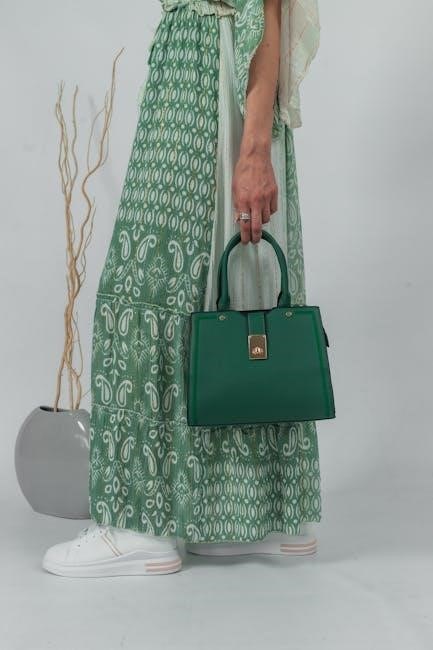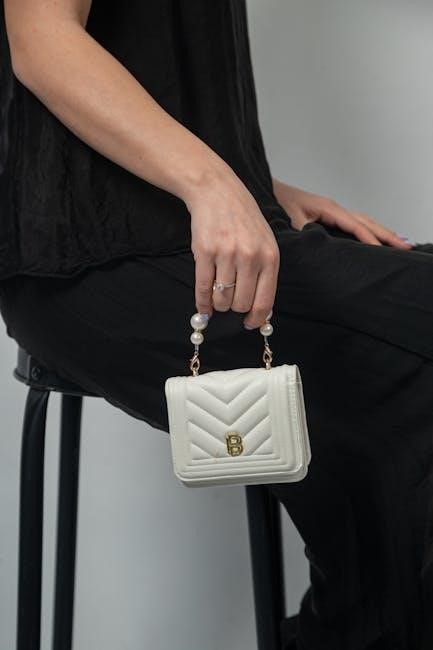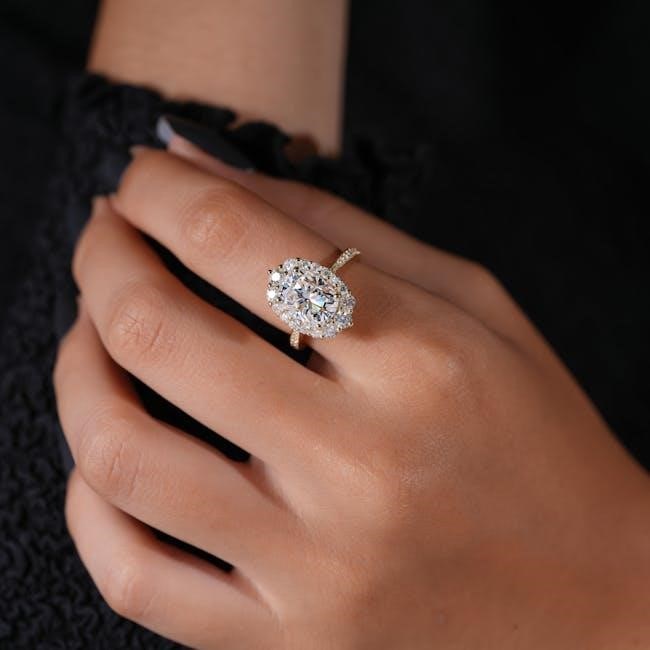A ring sling is a versatile and comfortable babywearing option, offering ease of use and adaptability for caregivers․ Lightweight and adjustable, it promotes closeness and convenience․
What is a Ring Sling?
A ring sling is a simple, adjustable baby carrier made from a piece of fabric secured by two metal rings at one end․ It allows for easy on-the-go adjustments, providing a snug and comfortable fit for both caregiver and baby․ Suitable from birth to toddlerhood, it is lightweight, compact, and versatile․ The design enables various carrying positions, making it a practical choice for daily use․ While it may require some practice to master, its simplicity and aesthetic appeal make it a popular option for many parents seeking a convenient and stylish way to carry their child;
Benefits of Using a Ring Sling
A ring sling offers numerous benefits for both caregivers and babies․ It provides a comfortable and secure way to carry children, promoting bonding and ease of movement․ Lightweight and compact, it is ideal for daily errands and outings․ The adjustable design allows for a customizable fit, accommodating different body types and baby sizes․ Ring slings are also versatile, supporting various carrying positions, from newborn cuddles to toddler exploration․ They foster a sense of closeness while keeping hands free, making them a practical and stylish choice for parents seeking convenience and comfort in their babywearing journey․
Who Can Use a Ring Sling?
A ring sling is a versatile babywearing option suitable for people of all body types and preferences․ Parents, grandparents, and other caregivers can use it comfortably․ It is ideal for babies from birth to toddlerhood, providing a secure and cozy environment for growth․ The adjustable design ensures a perfect fit for both petite and larger frames․ Additionally, ring slings are a great choice for dads, allowing them to bond with their babies while keeping up with daily activities․ Whether you’re running errands or enjoying a stroll, a ring sling offers practicality and comfort for all users․
Choosing the Right Ring Sling
Selecting the right ring sling involves considering fabric type, size, and features․ Opt for breathable materials like cotton or linen for comfort and durability․ Ensure proper fit and adjustable rings for versatility, accommodating different body types and carry styles․ Prioritize slings with sturdy construction and soft edges for baby’s comfort․ The ideal sling balances aesthetics and functionality, offering ease of use and long-lasting wear․ Research reviews and seek recommendations to find the best fit for your needs․ A well-chosen ring sling enhances your babywearing experience, ensuring comfort and convenience for both caregiver and child․
Understanding Fabric Types
Fabric choice is crucial for comfort and durability in a ring sling; Cotton is a popular option, known for its softness and breathability, making it ideal for everyday use․ Linen blends offer a lightweight and cool feel, perfect for warmer climates․ Bamboo fabrics are eco-friendly and moisture-wicking, great for sensitive skin․ Some slings feature decorative brocades or jacquards for a stylish touch․ Always opt for high-quality, woven fabrics that provide the right balance of support and flexibility․ The fabric’s texture and weight will impact the sling’s performance, so consider your climate and baby’s needs when selecting a material․
How to Measure for the Correct Size
To ensure a proper fit, measure from the top of your shoulder, down your torso, and around your natural hip curve․ This gives the optimal length for comfort․ For most, a medium or large sling is ideal, but sizes vary by brand․ Some slings are adjustable, offering flexibility for different wearers․ To test the fit, place the sling on your shoulder and adjust the rings to snugly secure your baby․ If using a doll or weighted object, ensure it sits high and close to your chest․ Proper sizing ensures both comfort and safety for you and your baby, making the sling easy to use and adjust․
Key Features to Look For
When selecting a ring sling, prioritize high-quality, breathable fabrics like cotton or linen for comfort and durability․ Ensure the rings are sturdy and smooth to adjust․ Opt for slings with reinforced stitching and a wide shoulder pad for better weight distribution․ Adjustable straps and a removable tail provide versatility for different body types and carrying styles․ Look for slings with a built-in pocket for convenience․ Consider slings with a hood or neck support for added comfort․ Always check for safety certifications and reviews to ensure reliability․ Aesthetic options like patterns and colors can also enhance your experience․ These features ensure comfort, safety, and longevity․
Preparing to Use a Ring Sling
Begin by unboxing and familiarizing yourself with the sling’s components․ Practice adjusting the rings to achieve a snug, comfortable fit․ Start with a doll or weighted object to build confidence and master the technique before placing your baby in the sling․
Unboxing and Initial Setup
Upon unboxing your ring sling, inspect for any damage or defects․ Gently remove packaging materials and lay the sling flat to examine the fabric and rings․ Ensure the rings are securely attached and functioning smoothly․ Familiarize yourself with the tail and shoulder sections․ Store the sling in a clean, dry place when not in use․ Before first use, consider washing the fabric according to care instructions to soften it for optimal comfort․
Adjusting the Rings for Optimal Fit
To achieve the perfect fit, start by loosening the rings completely․ Slide the sling over your shoulder, ensuring the fabric spreads evenly across your back․ Gently tighten the rings, pulling the tail through to secure the sling snugly around your torso․ Adjust until the sling feels comfortable and supportive, making sure the rings are level and the fabric isn’t twisted․ Practice adjusting the rings to find a balance between snugness and flexibility, allowing for easy movement while maintaining a secure fit․

Practicing with a Doll or Weighted Object
Before using your ring sling with your baby, practice with a doll or weighted object to build confidence and master the technique․ Start by placing the doll in the sling as you would your baby, ensuring proper positioning and support․ Adjust the rings to achieve a snug fit, simulating real-life scenarios․ Practice lifting, lowering, and securing the doll to understand how the sling moves and feels․ This step helps refine your skills, ensuring a smooth and safe experience when carrying your child․ Regular practice with a doll or weighted object will make you more comfortable and prepared for actual use․

Step-by-Step Instructions for Using a Ring Sling
Follow detailed guides to safely and effectively use a ring sling, ensuring comfort and security for both you and your baby․ Practice makes perfect․
Putting on the Sling
To put on the ring sling, start by holding it behind you with the rings at shoulder height․ Gently thread the tail through the rings, ensuring the fabric is not twisted․ Pull the tail downward to tighten the sling, adjusting the fit across your shoulder and back․ The sling should feel snug but not restrictive․ Make sure the rings are secure and the fabric is evenly spread for optimal comfort and support․ Adjust the sling while standing up straight or slightly bending at the knees for better balance․ This step sets the foundation for a comfortable and safe carry․
Placing the Baby in the Sling
Gently sit your baby into the sling, ensuring the fabric is not bunched or twisted․ For newborns, position them in a natural “frog leg” position with knees slightly bent․ For older babies, their legs can extend straight or be slightly bent․ Guide their back against the sling’s edge, ensuring their head is above the fabric for proper airflow․ Support their weight evenly, adjusting the sling to cradle them securely․ Make sure their face is visible and their airway is unobstructed․ This step ensures comfort and safety for your baby while being carried․
Securing the Baby with the Tail
After placing your baby in the sling, gently pull the tail of the sling to tighten it snugly around your baby․ Ensure the fabric is flat and even, with no bunching or twisting․ Tuck the tail under the sling and pull it back up through the rings to secure it firmly․ This step ensures the baby is held close to your body and prevents shifting․ Make sure the baby’s face is visible and their airway is unobstructed․ Adjust the tail as needed to maintain comfort and support, ensuring the baby’s weight is evenly distributed for a safe and secure carry․
Adjusting for Comfort and Safety
After securing your baby, fine-tune the sling by pulling the tail gently to ensure a snug fit․ Adjust the rings to distribute the baby’s weight evenly across your shoulders and chest․ Check that the baby’s knees are slightly higher than their hips and their spine is supported․ Ensure the fabric is not too tight or restrictive, allowing for natural movement․ Regularly monitor your baby’s position, ensuring their face is visible and their airway is clear․ Make small adjustments as needed to maintain comfort and safety, especially as your baby grows or moves․ This ensures a secure and enjoyable experience for both you and your baby․
Advanced Positions and Techniques
Explore front carry facing out, hip carry, and back carry for versatility․ These positions offer comfort and convenience as your baby grows and becomes more active․
Front Carry: Facing In
The front carry facing in position is ideal for newborns and younger babies, promoting closeness and easy breastfeeding․ To achieve this, place the baby high on your chest, with their head resting near your shoulder․ Ensure the sling is snug, with the fabric spread evenly across your back․ Adjust the rings to secure the baby firmly, keeping their knees slightly bent and bottom low․ Always check that your baby’s airway is clear and they are in a safe position․ This position allows for discreet nursing and fosters a deep bond between caregiver and child․
Front Carry: Facing Out
The front carry facing out position is perfect for curious babies who enjoy exploring their surroundings․ To achieve this, place your baby high on your chest, with their legs straddling your body․ Ensure the sling is snug, with the fabric spread evenly across your back․ The baby’s head should be at shoulder height, with their face clear for airflow․ This position is ideal for older babies who are naturally curious and want to engage with the world around them․ Always monitor your baby’s comfort and adjust the sling as needed for support and safety․ This carry fosters a sense of adventure and connection․
Hip Carry for Older Babies
The hip carry is an excellent option for older babies who have good head and neck control․ To set this up, position your baby on your hip, with their legs straddling your body․ Adjust the sling so the fabric is snug and evenly spread across your back․ Ensure the baby’s bottom is deep in the sling for optimal support․ This carry allows for easy breastfeeding and promotes a sense of independence for the baby․ It’s ideal for curious toddlers who enjoy exploring their surroundings while remaining close to you․ Always ensure the baby’s face is visible and their airway is clear for safety․
Back Carry for Toddlers
The back carry is an excellent option for toddlers who enjoy exploring their surroundings while being close to you․ To achieve this, place your toddler on your back, ensuring their legs are spread apart and their knees are slightly bent․ Adjust the sling so the fabric is snug and evenly distributed across your shoulders․ The toddler should be high enough on your back for their face to be visible and their airway clear․ This carry allows for easy movement and is ideal for older children who prefer to see the world around them․ Always ensure the sling is securely adjusted for both comfort and safety․

Safety Tips and Precautions
Always ensure proper airflow by keeping your baby’s face visible․ Monitor their position to prevent slouching and maintain a snug, upright fit․ Avoid loose fabric that could cause instability․
Ensuring Proper Airflow
Ensuring proper airflow is crucial for your baby’s comfort and safety in a ring sling․ Always position your baby so their face is uncovered and visible․ This allows for unobstructed breathing and prevents overheating․ Avoid letting fabric bunch up around their neck or head, as this can restrict airflow․ Additionally, keep your baby upright to promote clear airways․ Regularly check that their chest isn’t compressed, as this can impede breathing․ Properly adjusted slings help maintain a safe and breathable environment, ensuring your baby stays comfortable and secure during wear․ Always prioritize airflow to support healthy respiratory function․
Monitoring Baby’s Position
Monitoring your baby’s position in a ring sling is essential for their safety and comfort․ Ensure your baby is held in an upright position with their head at or above the sling’s edge․ This allows for easy breathing and visibility․ Keep their face uncovered and visible to you at all times․ Check that their chest is not compressed and their airway remains clear․ Regularly adjust the sling to support their natural spine curvature and maintain proper alignment․ Always verify that their knees are slightly bent and supported to prevent strain․ Regular checks ensure your baby stays safe and comfortable during wear․
Avoiding Common Mistakes
When using a ring sling, avoiding common mistakes ensures a safe and comfortable experience for both you and your baby․ A frequent error is not ensuring proper airflow, which can lead to overheating․ Avoid letting the sling ride too low, as it can compress your baby’s chest․ Never allow the fabric to cover your baby’s face, as this can obstruct breathing․ Additionally, refrain from over-tightening the sling, as it can cause discomfort or restrict movement․ Always check that the rings are securely adjusted and the fabric is evenly distributed․ Regular checks help prevent these issues and ensure a secure, enjoyable carry․

Troubleshooting Common Issues
Troubleshooting common issues with ring slings involves addressing discomfort, adjusting for fit, and resolving fabric or ring problems․ Regular checks and adjustments ensure optimal use and safety․
Why the Sling Feels Uncomfortable
A ring sling may feel uncomfortable due to improper sizing or uneven distribution of weight․ If the sling is too tight or too loose, it can cause strain․ Additionally, twisted fabric or poor ring adjustment can lead to discomfort․ Ensuring the rings are securely fastened and the fabric is smooth can help․ Practicing proper positioning and adjusting the sling to fit your body snugly is key․ Regular checks and adjustments ensure comfort for both wearer and baby, preventing long-term discomfort or fatigue․
Adjusting for Different Body Types
Adjusting a ring sling for various body types ensures comfort and proper fit․ For petite individuals, shorter straps or smaller rings may be necessary, while taller or broader frames might require longer straps․ The sling should sit high on the shoulder and across the back, avoiding pressure points․ Testing different positions and adjusting the fabric’s tightness can accommodate different physiques․ Customizing the fit based on body type enhances both comfort and functionality, ensuring the sling works well for all users regardless of size or shape․
Fixing a Twisted or Uneven Sling
If your ring sling becomes twisted or uneven, start by removing your baby and flattening the fabric․ Gently pull the edges to align the rails, ensuring the sling lies smoothly․ Adjust the rings by pulling the tail upward to even out the fabric․ If the sling remains uneven, try threading it through the rings again, ensuring the fabric is not bunched․ Practice adjusting the sling on your body to achieve a balanced fit․ A properly adjusted sling ensures comfort and safety for both you and your baby, making it easier to carry your little one securely․

Caring for Your Ring Sling
Regularly wash your ring sling with mild detergent to maintain hygiene and softness․ Store it in a cool, dry place when not in use to preserve quality and longevity․
Washing and Drying Instructions
To maintain the quality and comfort of your ring sling, wash it in cold water using a gentle detergent․ Avoid using bleach or harsh chemicals, as they can damage the fabric․ Gently agitate the sling by hand or use a delicate cycle on your washing machine․ After washing, reshape the sling while it’s damp to prevent stretching or shrinkage․ Air dry it away from direct sunlight to preserve the colors and fabric integrity․ Do not iron the sling, as high heat can damage the material or the rings․
Storing the Sling When Not in Use
Store your ring sling in a cool, dry place to prevent moisture buildup and fabric degradation․ Avoid direct sunlight, as it may fade the colors or weaken the material․ Use a breathable storage bag or cloth to protect the sling from dust․ Keep it away from children and pets to prevent accidental damage․ Before storing, ensure the sling is clean and dry to avoid mold or mildew․ Lay it flat or hang it to maintain its shape․ This will help preserve the sling’s quality and ensure it remains comfortable for future use․
Maintaining the Rings and Fabric
Regularly inspect and clean the rings and fabric to ensure longevity․ Spot clean stains with a mild detergent and lukewarm water․ Avoid harsh chemicals or abrasive cleaners, as they can damage the material․ For the rings, gently wipe them with a soft cloth to remove dirt or oils․ Store the sling in a dry, cool place to prevent mold or mildew․ Do not machine wash unless necessary, and always air dry․ Proper maintenance will keep your ring sling in excellent condition, ensuring safety and comfort for you and your baby over time․
Mastering the ring sling offers a convenient and loving way to carry your baby․ With practice, patience, and proper care, it becomes an indispensable tool for everyday life․
Final Tips for Successful Ring Sling Use
Consistency and patience are key to mastering the ring sling․ Start with short sessions and gradually increase time as both you and your baby grow comfortable․ Always ensure proper airflow and monitor your baby’s position to maintain safety․ Adjust the sling regularly for optimal comfort and support․ Practice different carries as your baby grows, and don’t hesitate to seek guidance from online tutorials or communities․ With time, the ring sling will become a trusted companion, offering convenience and closeness throughout your parenting journey․ Remember, confidence grows with practice, so keep experimenting until you find what works best for you and your child․
Encouragement and Next Steps
Celebrate small victories, like mastering a new carry or enjoying a hands-free outing, to build confidence․ Join online communities or local babywearing groups for support and inspiration․ Experiment with different fabrics and styles to find your favorites․ As your baby grows, explore advanced positions like back carries for toddlers․ Remember, every caregiver’s journey is unique, and it’s okay to take time to find what works best for you․ Embrace the flexibility of ring slings and enjoy the bonding experience they provide․ Happy babywearing!
